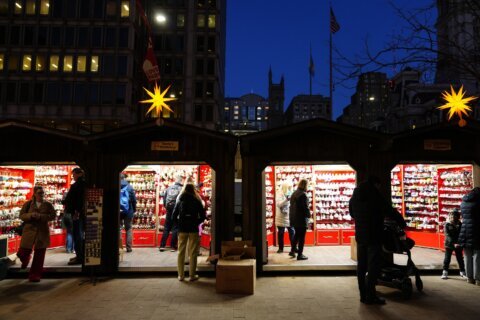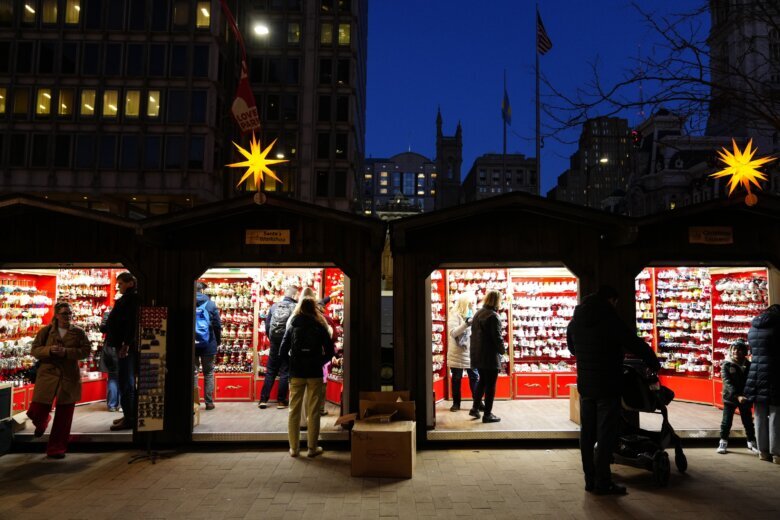
NEW YORK (AP) — Americans stepped up their spending at retailers in December, closing out the holiday shopping season and the year on an upbeat tone and signaling that people remain confident enough to keep spending freely.
Retail sales accelerated 0.6% in December from November’s 0.3% increase, the Commerce Department reported Wednesday. Because spending by consumers accounts for nearly 70% of the U.S. economy, the report suggested that shoppers will be able to keep fueling economic growth this year.
Among last month’s overall retail purchases, sales at stores that sell general merchandise rose 1.3%. Sellers of clothing and accessories reported a 1.5% increase, as did online sellers. By contrast, furniture and home furnishings businesses declined 1%, reflecting a struggling housing market. Sales at restaurants were unchanged in December.
Economists had expected consumers to pull back on spending in the final three months of the year under the weight of credit card debt and delinquencies and lower savings. Yet despite those challenges, along with higher borrowing costs, tighter credit conditions and price increases, household spending is being fueled by a strong job market and rising wages.
The healthy rise in purchasing last month also highlights an apparent contradiction at the heart of the economy: Surveys suggest that Americans feel sour about the economy overall and exasperated by the increased cost of food, rent, cars and other items over the past two years. Yet the ongoing strength of their spending speaks for itself, indicating confidence in the economy and their own finances.
Inflation has cooled significantly since peaking at 9.1% in mid-2022. But costs can still flare. Higher energy and housing prices boosted overall U.S. inflation in December, a sign that the Federal Reserve’s drive to slow inflation to its 2% target will likely remain a bumpy one.
“The U.S consumer continues to hold up well, which is a positive for the economy,” said Larry Tentarelli, chief technical strategist at Blue Chip Daily Trend Report.
But Tentarelli said the latest data, along with other recent signs that the economy remains solid overall, does lessen the likelihood that the Federal Reserve will cut interest rates soon.
On Wednesday, Christopher Waller, a key member of the Fed’s Board of Governors, said that as long as the economy remains healthy, the central bank can proceed cautiously as it determines when and by how much to cut its benchmark interest rate. His remarks were seen by economists and investors as downplaying the potential for a rate cut as early as March, which Wall Street investors and economists had expected.
Meanwhile, polls show many Americans are still pessimistic. That disconnect, a likely hot topic in the 2024 elections, has confounded economists and political analysts. A major factor is the lingering financial and psychological effects of the worst bout of inflation in four decades. Much of the public remains exasperated by prices that, despite falling inflation, remain 17% higher than they were before prices began to surge.
Yet the holiday shopping season, the most critical for retailers, has turned out to be a decent one, according to some recent data.
The National Retail Federation, the nation’s largest retail trade group, said Wednesday that holiday sales rose 3.8% for the November and December period compared to the same year-ago period. That was in line with its forecast for 3% to 4% growth. It also surpasses the average annual holiday increase of 3.6% from 2010 to 2019 before the pandemic created outsized spending.
Mastercard SpendingPulse said last month that holiday sales from the beginning of November through Christmas Eve climbed 3.1%. Mastercard SpendingPulse tracks all kinds of payments including cash and debit cards.
While that’s less than half the 7.6% increase from a year earlier, this year’s sales are more in line with what is typical during the holiday season.
Stephen Lebovitz, CEO of mall operator CBL Properties, said that a last-minute shopping surge helped many tenants post sales increases for the holiday season, based on a spot check of tenants. He noted that shoppers are still coping with high interest rates and still high inflation but unemployment is low and wages are growing.
“I think 2024 is going to be similar (to 2023),” he said. “It’s not going to be robust growth. But I think it will be solid.”
Lebovitz also added that demand for leasing is strong, and he doesn’t expect any pickup in retail bankruptcies after the holidays.
Ted Rossman, senior industry analyst at Bankrate.com, noted that consumer spending was “remarkably strong” during the holidays, but he added, “I do worry, however, how people are paying for all of this stuff. ”
Rossman noted that credit card balances and rates were already at record highs even before the holiday splurge. And buy now, pay later plans— which let shoppers break up the cost of an item over time — have spiked from last holiday season.
Big retailers are also monitoring potential disruptions to shipping in the Red Sea.
Attacks by Houthi rebels on cargo ships don’t pose major near-term implications because shipping during this time of the year for retailers is lighter, said Balika Sonthalia, senior partner and Americas co-lead in the operations and performance practice of global strategy and management consultancy Kearney. But if the attacks become a long-term issue, it could be different story.
___
AP Economics Writer Christopher Rugaber in Washington contributed to this report.
Copyright © 2024 The Associated Press. All rights reserved. This material may not be published, broadcast, written or redistributed.








